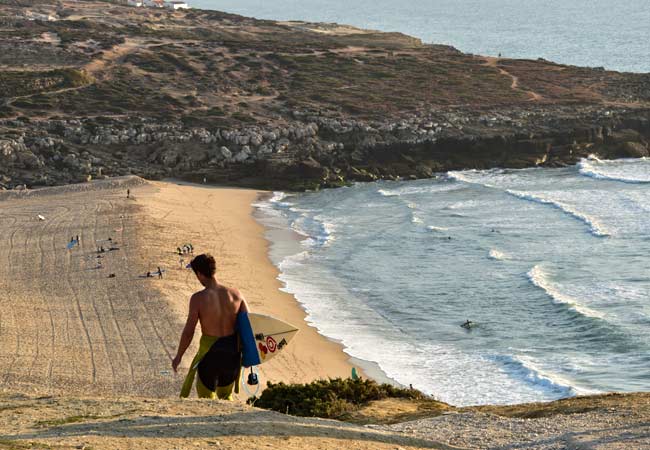MyPortugalHoliday.com
The best independent guide to Portugal
MyPortugalHoliday.com
The best independent guide to Portugal
Why is the sea in Portugal so cold?
You've arrived at a stunning Portuguese beach. The sun is blazing, the sand is perfect, and you're ready to dive into those crystal-clear waters. Then your toe touches the ocean and shock! The Atlantic here feels more like the Baltic Sea than the Mediterranean paradise you were expecting.
Even in peak summer, when air temperatures soar above 34°C, the ocean rarely climbs above 20°C. So, what's going on?
The Canary Current: Portugal's Natural Air Conditioner
The main culprit behind Portugal's surprisingly cold sea is the Canary Current, a vast, cold-water current flowing south from the North Atlantic. Originating near Greenland and Iceland, this current acts like a massive river within the sea, carrying frigid waters down the western coast of Europe and Africa. As it passes Portugal, it keeps coastal waters significantly cooler than you'd expect for a country on the same latitude as many balmy Mediterranean destinations.
Think of it as nature's air conditioning. While inland Portugal swelters in the summer heat, the sea maintains its chilly disposition year-round, constantly refreshed by this influx of cool water from the north.
Insight: The Canary Current moves at about 400-700 meters per hour southwards, constantly refreshing the coastline with cold water from northern latitudes.
The Upwelling Effect: When Deep Meets Surface
The story of Portugal's cold sea gets even more interesting thanks to a phenomenon called upwelling. During the summer months, strong prevailing winds, known locally as the Nortada, blow along the coast. These winds push the warmer surface water away from the shore, creating a void that pulls cold, nutrient-rich water up from the deep-sea floor to replace it.
This upwelling is particularly intense along Portugal's west coast, especially between June and September, ironically, the exact time tourists expect the warmest swimming conditions. The deep water that surfaces can be 5-10°C colder than the water it replaces, leading to those gasp-inducing dips that catch so many visitors by surprise.
Geography's Role: The Atlantic vs. Mediterranean Divide
Portugal's position on the vast Atlantic, rather than the enclosed Mediterranean Sea, is fundamental to its water temperatures. The Mediterranean is often compared to a giant bathtub-it's relatively shallow, enclosed, and warms up significantly during the summer. The Atlantic, in contrast, is immense, deep, and constantly in motion.
Just a few kilometres off Portugal's west coast, the continental shelf drops off dramatically into the deep sea. This proximity means there is always a vast reservoir of cold water nearby, ready to mix with surface waters and keep temperatures down. Compare this to the gradual shelving of many Mediterranean coasts, where shallow waters can bake in the summer sun.

Regional Variations: Not All Portuguese Beaches Are Created Equal
Interestingly, not all of Portugal's coastline experiences the same degree of coldness. The Algarve's south-facing beaches, protected from the full force of the Atlantic and the Nortada winds, typically enjoy warmer waters, sometimes reaching 22-23°C in August. The east Algarve, near the Spanish border, can be even warmer as it begins to feel the Mediterranean's influence.
Meanwhile, the west coast from Lisbon northward experiences the full effect of the cold currents and upwelling. Popular surf spots like Ericeira and Peniche rarely see water temperatures above 18°C, even in peak summer. The Silver Coast (Costa de Prata) earns its name not just from its stunning beaches but also from the silvery shimmer of its perpetually cool waters.
Seeking a Warmer Dip? Head to the Lagoons and Sheltered Bays
For those who dream of a less bracing swim, Portugal offers wonderful alternatives to the open Atlantic. Along the coast, you'll find stunning lagoons and uniquely sheltered bays where the water is noticeably warmer and calmer.
A prime example is the Lagoa de Óbidos, a vast coastal lagoon separated from the sea by a sandbar. Its shallower waters heat up much faster in the sun than the deep Atlantic, making it a favourite for families and watersports enthusiasts. Similarly, the Praia da Lagoa de Albufeira, south of Lisbon, is a beautiful lagoon system where the water is shallower, protected from the cold currents, and perfect for a more comfortable dip.
Further up the Silver Coast, the town of São Martinho do Porto is built around a stunning, near-perfect, shell-shaped bay. A narrow opening to the sea protects it almost completely from the Atlantic swell and currents. This natural harbour acts like a great solar collector, with calm, shallow waters that are reliably several degrees warmer than the sea just on the other side of the cliffs.

The Lagoa de Obidos on a busy summer’s day
The Silver Lining: Why Cold Water Is Actually Good News
Before you decide against packing your swimwear, consider the incredible benefits of Portugal's cold sea. The same upwelling that makes the water chilly also makes it phenomenally rich in nutrients. This creates one of the world's most productive marine ecosystems, supporting the abundant fish populations that are the bedrock of Portugal's cuisine. Those famous Portuguese sardines? They thrive in these cold, plankton-rich waters.
Furthermore, the temperature difference between the sea and the land helps generate the consistent winds and waves that make Portugal one of Europe's premier surf destinations.
Embracing the Atlantic Experience
Portugal's cold sea is an integral part of its identity. It has shaped the nation's culture, cuisine, and coastal character. While it may not offer the bath-like warmth of other destinations, it provides something more: a raw and genuine Atlantic experience, complete with dramatic waves, pristine beaches, and some of the best seafood in the world. Once you understand the reasons for its temperature, you can truly appreciate the invigorating chill as part of Portugal's authentic charm.
Discover more of central Portugal with our guides
























